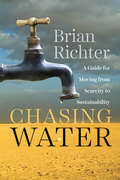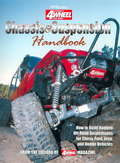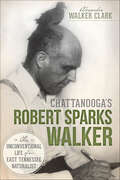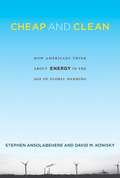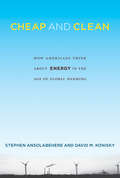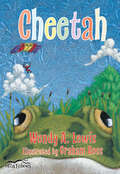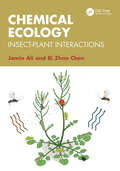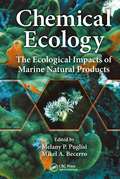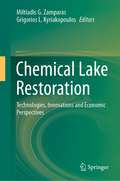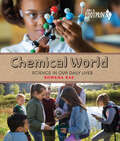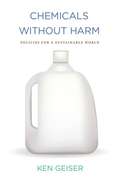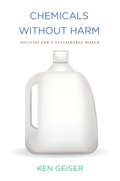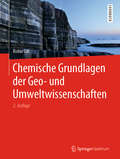- Table View
- List View
Chasing Spring: An American Journey Through a Changing Season
by Bruce StutzIn the tradition of Blue Highways and Silent Spring, Chasing Spring follows nature's season of renewal even as it shows how the delicate mechanisms of spring are increasingly endangered by climate change. Seeking to revive his body and soul following heart surgery, acclaimed nature writer Bruce Stutz set out on a three-month journey through the unfolding of an American spring. Driving across the country in a twenty-year-old Chevy sedan, Stutz shows readers that spring is not so much a progression as an arousal; each added minute of the lengthening days and lingering sun brings yet another transformation in the greening landscape as well as in the human spirit. Beginning with the season's southernmost stirrings along the Gulf of Mexico, Stutz sees the first blooms and partakes in the season's festivals -- celebrations with ancient origins that still speak to our wonder at nature's annual rebirth. He follows the migrations of birds northward, the return of life to the forests, and the quickening of snowmelt in the Rockies. He moves across the southern desert, encountering the explosion of cacti and wildflowers and the violence of tornadoes on the drought-stricken Great Plains. He then travels north through the national parks of the West, finally celebrating his journey's end by basking at the solstice amid the beauty of the Alaskan Arctic's twenty-four hours of daylight. Along the way, he accompanies scientists into the field to study the season's changes and meets farmers, Arctic natives, and even migrant mushroom pickers whose livelihoods depend on the coming of spring. In each location, as he observes the sensitive interplay of light and warmth that draws animals, plants, water, and even the soil itself into the biological ballet that makes for the profound stirring we call spring, he also finds that climate change now threatens the basic processes of nature. A moving and thought-provoking record of the year¹s most invigorating season, Chasing Spring is a timely reminder that as trees bud and flowers bloom, the human spirit reawakens as well. Anyone who has ever marveled at spring¹s wondrous transformations?from a first garden blossom to a world in full flower?will find in Chasing Spring a journey to savor.
Chasing Warblers
by Vera Thornton Bob ThorntonKnown to many as "the butterflies of the bird world," wood warblers allure even the most experienced and discriminating birders. Their annual migrations to and from nesting areas in the United States and Canada draw thousands of birders to places such as High Island, Texas; Crane Creek, Ohio; and Point Pelee, Ontario, where warblers stop to rest and feed during the long journey. There birders have a chance to see and photograph these colorful, elusive songbirds whose quick, darting flight among high branches and thick cover makes them some of the most challenging birds to observe and identify. In this entertaining, beautifully illustrated book, Bob Thornton recounts his and Vera Thornton's cross-continent adventures in finding and photographing all 52 species of wood warblers that nest in the United States. In addition to describing where and how they photographed each species, Thornton tells marvelous stories of the colorful characters they encountered along the way. He also touches on the current human threats to wood warblers that come from loss of habitat.
Chasing Water: A Guide for Moving from Scarcity to Sustainability
by Brian RichterWater scarcity is spreading and intensifying in many regions of the world, with dire consequences for local communities, economies, and freshwater ecosystems. Current approaches tend to rely on policies crafted at the state or national level, which on their own have proved insufficient to arrest water scarcity. To be durable and effective, water plans must be informed by the culture, economics, and varied needs of affected community members. International water expert Brian Richter argues that sustainable water sharing in the twenty-first century can only happen through open, democratic dialogue and local collective action. In Chasing Water, Richter tells a cohesive and complete story of water scarcity: where it is happening, what is causing it, and how it can be addressed. Through his engaging and nontechnical style, he strips away the complexities of water management to its bare essentials, providing information and practical examples that will empower community leaders, activists, and students to develop successful and long-lasting water programs. Chasing Water will provide local stakeholders with the tools and knowledge they need to take an active role in the watershed-based planning and implementation that are essential for water supplies to remain sustainable in perpetuity.
Chasing the Ghost: My Search for all the Wild Flowers of Britain
by Peter Marren**ONE OF THE GUARDIAN’S BEST BOOKS OF 2018**Join renowned naturalist Peter Marren on an exciting quest to see every species of wild plant native to Britain.The mysterious Ghost Orchid blooms in near darkness among rotting leaves on the forest floor. It blends into the background to the point of invisibility, yet glows, pale and ghostly. The ultimate grail of flower hunters, it has been spotted only once in the past twenty-five years. Its few flowers have a deathly pallor and are said to smell of over-ripe bananas. Peter Marren has been a devoted flower finder all his life. While the Ghost Orchid offers the toughest challenge of any wild plant, there were fifty more British species Peter had yet to see, having ticked off the first 1,400 rummaging in hedges, slipping down gullies and peering in peat bogs. But he set himself the goal of finding the remaining fifty in a single summer. As it turned out, the wettest summer in years. This expert and emotional journey takes Peter the length and the breadth of the British Isles, from the dripping ancient woods of the New Forest to the storm-lashed cliffs of Sutherland. He paddles in lakes, clambers up cliffs in mist and rain, and walks several hundred miles, but does he manage to find them all? Partly about plants, partly autobiography, Chasing the Ghost is also a reminder that to engage with wild flowers, all we need to do is look around us and enjoy what we see. Praise for Chasing the Ghost:‘Peter Marren is the unsung hero of Britain’s nature writers’ Stephen Moss, author of Dynasties‘Jolly, quixotic and ends with real poignancy’ Guardian ‘A poignant reminder to us all to engage with the wild flowers that grow around us’ i Newspaper
Chassis & Suspension Handbook HP1406
by Carl MunroeChassis and suspension modifications for Chevy, Ford, Jeep and Dodge trucks. Includes sections on lift kits, shocks, springs, chassis modifications for off-road use, tires and wheels.
Chattanooga's Robert Sparks Walker: The Unconventional Life of an East Tennessee Naturalist (Natural History)
by Alexandra Walker ClarkThe legend that was Robert Sparks Walker began in a log cabin outside Chattanooga called Spring Frog Cabin, a humble abode built by a Cherokee naturalist in 1750. Walker would continue in the footsteps of that Cherokee to become synonymous both with Chattanooga and nature, penning thousands of articles, poems and books as a naturalist. Nominated for a Pulitzer Prize, Walker gained international fame for his work, yet his largest impact remains in his native Tennessee. He helped to found the Chattanooga Audubon Society, including preserving his childhood home through Audubon Acres. Walker is remembered throughout the state for his nationally syndicated nature column, and the Lifetime Achievement Award for Environmental Stewardship is given in his name. His life was one of adventure, reflection and a deep devotion to the understanding and preservation of nature. Local author Alexandra Walker Clark, granddaughter of Robert Sparks Walker, celebrates the life of this Scenic City pioneer.
Chattooga River, The: A Natural and Cultural History (Natural History)
by Laura Ann GarrenThe Chattooga River has run through the American consciousness since the movie "Deliverance" thrust it into the national spotlight. But this National Wild and Scenic River is much more than the make-believe set of a suburbanite nightmare. People travel from all over the country to run its rapids, cast into its current for trout and hike the miles of trails that meander through thousands of acres of woods in the Chattooga watershed. One of the last free-flowing rivers in the Southeast, the river muscles fifty-seven miles through a southern deciduous forest with one of the highest levels of biodiversity in the country and is home to many species of rare wildflowers. Join author Laura Ann Garren as she describes the history and wonder of the real Chattooga River.
Cheap and Clean
by Stephen Ansolabehere David M. KoniskyHow do Americans think about energy? Is the debate over fossil fuels highly partisan and ideological? Does public opinion about fossil fuels and alternative energies divide along the fault between red states and blue states? And how much do concerns about climate change weigh on their opinions? In Cheap and Clean, Stephen Ansolabehere and David Konisky show that Americans are more pragmatic than ideological in their opinions about energy alternatives, more unified than divided about their main concerns, and more local than global in their approach to energy. Drawing on extensive surveys they designed and conducted over the course of a decade (in conjunction with MIT's Energy Initiative), Ansolabehere and Konisky report that beliefs about the costs and environmental harms associated with particular fuels drive public opinions about energy. People approach energy choices as consumers, and what is most important to them is simply that energy be cheap and clean. Most of us want energy at low economic cost and with little social cost (that is, minimal health risk from pollution). The authors also find that although environmental concerns weigh heavily in people's energy preferences, these concerns are local and not global. Worries about global warming are less pressing to most than worries about their own city's smog and toxic waste. With this in mind, Ansolabehere and Konisky argue for policies that target both local pollutants and carbon emissions (the main source of global warming). The local and immediate nature of people's energy concerns can be the starting point for a new approach to energy and climate change policy.
Cheap and Clean: How Americans Think about Energy in the Age of Global Warming (The\mit Press Ser.)
by Stephen Ansolabehere David M. KoniskyHow Americans make energy choices, why they think locally (not globally), and how this can shape U.S. energy and climate change policy.How do Americans think about energy? Is the debate over fossil fuels highly partisan and ideological? Does public opinion about fossil fuels and alternative energies divide along the fault between red states and blue states? And how much do concerns about climate change weigh on their opinions? In Cheap and Clean, Stephen Ansolabehere and David Konisky show that Americans are more pragmatic than ideological in their opinions about energy alternatives, more unified than divided about their main concerns, and more local than global in their approach to energy.Drawing on extensive surveys they designed and conducted over the course of a decade (in conjunction with MIT's Energy Initiative), Ansolabehere and Konisky report that beliefs about the costs and environmental harms associated with particular fuels drive public opinions about energy. People approach energy choices as consumers, and what is most important to them is simply that energy be cheap and clean. Most of us want energy at low economic cost and with little social cost (that is, minimal health risk from pollution). The authors also find that although environmental concerns weigh heavily in people's energy preferences, these concerns are local and not global. Worries about global warming are less pressing to most than worries about their own city's smog and toxic waste. With this in mind, Ansolabehere and Konisky argue for policies that target both local pollutants and carbon emissions (the main source of global warming). The local and immediate nature of people's energy concerns can be the starting point for a new approach to energy and climate change policy.
Cheers for a Dozen Ears
by Susan Swan Felicia Sanzari CherneskySummertime means fresh veggies at the farm stand to pick out and count! This concept book follows a family's stop at the farm stand as they count tomatoes, strawberries, sunflowers--and yes, ears of corn. Felicia Sanzari Chernesky's simple verses are beautifully accompanied by Susan Swan's collage art.This is a fixed-format ebook, which preserves the design and layout of the original print book.
Cheetah (Orca Echoes)
by Wendy A. LewisCheetah is the small spotted frog Amelia brings home in a macaroni container. Amelia longs to keep Cheetah forever, but over the course of a week, she comes to understand that his place is back in the wild. Cheetah is based on a true story, and all the characters are real.
Cheetahs (Nature's Children)
by Alia SmithWhat has spots, hunts gazelles and can run faster than any other animal on Earth? You guessed it, the cheetah. Learn all kinds of exciting things about this fascinating member of the cat family.
Chemical Defense in Nature: Structure, Function, and Synthesis of Toxic Secondary Metabolites from Plants and Animals
by Vladimir V. KouznetsovThe book examines biological processes vital for organism survival through a chemical lens. Integrating core organic chemistry concepts, such as structural analysis and synthesis, explores how plants and animals produce and utilize toxic organic molecules for growth, survival, and reproduction.The book focuses on the intricate structures, vital functions, and synthesis pathways of toxic secondary metabolites from plants and animals, illustrating toxic substances' intricate chemical relationships and biological significance. The book addresses the following main questions: Why do animals and plants accumulate these toxic substances? What structures do these compounds have? What effects can they have on man? Can they be prepared in the laboratory and used for medicinal purposes?This book delves into the fascinating world of toxic secondary metabolites in plants and animals, bridging chemistry and biology to unravel their roles in survival. With an interdisciplinary approach, it is a valuable resource for researchers, students, and professionals in phytochemistry, organic chemistry, and medical sciences.
Chemical Ecology of Insects: Applications and Associations with Plants and Microbes
by Jun TabataInsects have evolved very unique and interesting tactics using chemical signals to survive. Chemical ecology illustrates the working of the biological network by means of chemical analyses. Recent advances in analytical technology have opened the way to a better understanding of the more complicated and abyssal interactions of insects with other organisms including plants and microbes. This book covers recent research on insects and chemical communications and presents the current status about challenges faced by chemical ecologists for the management of pests in agriculture and human health.
Chemical Ecology: Insect-Plant Interactions
by Jamin Ali Ri Zhao ChenThis textbook provides a comprehensive overview of the principles, methods and applications of chemical ecology, covering such topics as chemical signalling, predator–prey interactions, host plant selection and chemical defence. The book takes the reader through the historical development of the discipline to current state-of-the-art research, delving into recent findings on the role of chemical ecology in conservation and management and exploring how the field may contribute to future innovations in ecological science. A chapter is dedicated to the techniques that have been used in chemical ecology and some success stories.Chemical Ecology: Insect-Plant Interactions is an important resource for advanced undergraduates and postgraduate researchers as well as practitioners in this interdisciplinary field. The book’s layout aligns with the curriculum of chemical-ecology-related disciplines, progressing from basic fundamental principles to a more advanced level. Those studying and researching in ecology, entomology, plant biology and biochemistry will find it invaluable as well as those practising in areas such as agriculture, forestry and pest management.
Chemical Ecology: The Ecological Impacts of Marine Natural Products
by Melany P. Puglisi Mikel A. BecerroDuring the past 20 years, marine chemical ecology has emerged as a respected field of study providing a better understanding of the role natural products play in organisms and their environments. Ample data in this book advocates the conservation of marine environments for future drug discovery efforts while sustaining their overall health. Marine chemical ecology has expanded to include research in the areas of predator–prey interactions, marine microbial chemical ecology, and seasonal and geographical distribution of marine natural products.
Chemical Lake Restoration: Technologies, Innovations and Economic Perspectives
by Miltiadis G. Zamparas Grigorios L. KyriakopoulosThis book aims to structure, in a complete and sequential way, the mainstream technical knowledge which is related to eutrophication control. The book considers the development of innovative technologies for phosphate removal, while supporting the restoration of currently degraded lakes and reservoir systems. In addition, this book contains key-aspects of future benchmark interests being specially framed under the ongoing development of a circular economy. In particular, the book will contribute to a better understanding of the problem of internal P-loads and P-sources disposition towards a more effective control of nutrients’ enrichment in lakes. The chemical routes and environmental fate of such lake nutrients will be viewed in the light of innovative technologies (engineering dimensions) and circular economy perspectives (economics dimensions). The main theme extends to an economic appreciation of environmental polluted aquifers. The book will appeal to an interdisciplinary audience, covering a wide spectrum of scientific fields, such as environment, physical chemistry, surface chemistry, interfacial phenomena, coastal engineering, bio-engineering, environmental policy makers, and economists.
Chemical World: Science in Our Daily Lives (Orca Footprints #17)
by Rowena RaeDespite people using both natural and synthetic chemicals with (mainly) good intentions, some chemicals have had unintended negative consequences. Chemical residues have contaminated ecosystems the world over and are compromising the health of many ecosystems, animals and humans. The goal of Chemical World: Science in our Daily Lives is to introduce readers to basic chemistry and chemical history, and to show how chemicals are used for particular reasons but sometimes turn out to be harmful to environmental and human health. It invites readers to take a look at the world around them and ask questions about what’s in their environment and how the things they use and eat every day can affect their own health and the planet’s health. Chemical World: Science in Our Daily Lives explores some of the materials—all of which are made of basic chemical elements—that humans use or come into contact with in their day-to-day lives. Some of these chemicals are naturally occurring—clay, mercury, lead. Others have been synthesized by chemists during the past 150 years and used in a bewildering array of products ranging from roof shingles to toothpaste. Many chemical inventions, as well as naturally produced chemicals, have had profound effects on food supply, developing medicines and creating hosts of useful items for modern life. The epub edition of this title is fully accessible.
Chemicals without Harm
by Ken GeiserToday, there are thousands of synthetic chemicals used to make our clothing, cosmetics, household products, electronic devices, even our children's toys. Many of these chemicals help us live longer and more comfortable lives, but some of these highly useful chemicals are also persistent, toxic, and dangerous to our health and the environment. For fifty years, the conventional approach to hazardous chemicals has focused on regulation, barriers, and protection. In Chemicals without Harm, Ken Geiser proposes a different strategy, based on developing and adopting safer alternatives to hazardous chemicals rather than focusing exclusively on controlling them. Geiser reviews past government policies focused on controlling chemicals, describes government initiatives outside the United States that have begun to implement a more sustainable chemical policy, and offers an overview of the chemicals industry and market. He develops a safer chemicals policy framework that includes processes for characterizing, classifying, and prioritizing chemicals; generating and using new chemical information; and promoting transitions to safer chemicals. The shift in strategy described by Geiser will require broad changes in science, the chemicals economy, and government policy. Geiser shows that it is already beginning, identifying an emerging movement of scientists, corporate managers, environmental activists, and government leaders who are fashioning a new, twenty-first-century approach to chemicals.
Chemicals without Harm
by Ken GeiserToday, there are thousands of synthetic chemicals used to make our clothing, cosmetics, household products, electronic devices, even our children's toys. Many of these chemicals help us live longer and more comfortable lives, but some of these highly useful chemicals are also persistent, toxic, and dangerous to our health and the environment. For fifty years, the conventional approach to hazardous chemicals has focused on regulation, barriers, and protection. In Chemicals without Harm, Ken Geiser proposes a different strategy, based on developing and adopting safer alternatives to hazardous chemicals rather than focusing exclusively on controlling them. Geiser reviews past government policies focused on controlling chemicals, describes government initiatives outside the United States that have begun to implement a more sustainable chemical policy, and offers an overview of the chemicals industry and market. He develops a safer chemicals policy framework that includes processes for characterizing, classifying, and prioritizing chemicals; generating and using new chemical information; and promoting transitions to safer chemicals. The shift in strategy described by Geiser will require broad changes in science, the chemicals economy, and government policy. Geiser shows that it is already beginning, identifying an emerging movement of scientists, corporate managers, environmental activists, and government leaders who are fashioning a new, twenty-first-century approach to chemicals.
Chemicals without Harm: Policies for a Sustainable World (Urban and Industrial Environments)
by Ken GeiserA proposal for a new chemicals strategy: that we work to develop safer alternatives to hazardous chemicals rather than focusing exclusively on controlling them.Today, there are thousands of synthetic chemicals used to make our clothing, cosmetics, household products, electronic devices, even our children's toys. Many of these chemicals help us live longer and more comfortable lives, but some of these highly useful chemicals are also persistent, toxic, and dangerous to our health and the environment. For fifty years, the conventional approach to hazardous chemicals has focused on regulation, barriers, and protection. In Chemicals without Harm, Ken Geiser proposes a different strategy, based on developing and adopting safer alternatives to hazardous chemicals rather than focusing exclusively on controlling them. Geiser reviews past government policies focused on controlling chemicals, describes government initiatives outside the United States that have begun to implement a more sustainable chemical policy, and offers an overview of the chemicals industry and market. He develops a safer chemicals policy framework that includes processes for characterizing, classifying, and prioritizing chemicals; generating and using new chemical information; and promoting transitions to safer chemicals. The shift in strategy described by Geiser will require broad changes in science, the chemicals economy, and government policy. Geiser shows that it is already beginning, identifying an emerging movement of scientists, corporate managers, environmental activists, and government leaders who are fashioning a new, twenty-first-century approach to chemicals.
Chemische Grundlagen der Geo- und Umweltwissenschaften
by Robin GillChemische Grundlagen sind die Basis für einen großen Teil der Geowissenschaften. Studierende der Geowissenschaften benötigen daher zunehmend ein solides Verständnis der chemischen Grundlagen, um ihr Studium erfolgreich zu absolvieren. Die erweiterte zweite Auflage dieses beliebten Lehrbuchs führt die Studenten in diese "georelevante" Chemie ein, die in demselben klaren und verständlichen Stil wie die Vorauflage präsentiert wird. Die neue Auflage wurde jedoch um den Bereich der Umweltgeowissenschaften erweitert und enthält ein neues Kapitel, in dem die Isotopengeochemie vorgestellt wird.Das Buch umfasst drei große, gegliederte Teile. Der erste (Kapitel 1-4) befasst sich mit der grundlegenden physikalischen Chemie geologischer Prozesse. Der zweite Teil (Kapitel 5-8) führt in die wellenmechanische Sicht auf das Atom ein und erklärt die verschiedenen Arten chemischer Bindungen, die den Materialien der Erde ihre vielfältigen und charakteristischen Eigenschaften verleihen. Die Schlusskapitel (9-11) geben einen Überblick über die geologisch relevanten Elemente und Isotope und erklären ihre Entstehung und ihre Häufigkeit im Kosmos und auf der Erde. Das Buch schließt mit einem umfangreichen Glossar von Begriffen; die Anhänge behandeln grundlegende Mathematik, erklären die grundlegende Lösungschemie und listen die chemischen Elemente und die im Buch verwendeten Symbole, Einheiten und Konstanten auf.Die Übersetzung wurde mit Hilfe von künstlicher Intelligenz (maschinelle Übersetzung durch den Service DeepL.com) angefertigt. Da die anschließende Überprüfung hauptsächlich im Hinblick auf inhaltliche Gesichtspunkte erfolgte, kann sich der Text des Buches stilistisch von einer konventionellen Übersetzung unterscheiden. Springer Nature arbeitet bei der Publikation von Büchern kontinuierlich mit innovativen Technologien, um die Arbeit der Autoren unterstützen.
Chemistry of Sustainable Energy
by Nancy E. CarpenterUnderstanding the chemistry underlying sustainable energy is central to any long-term solution to meeting our future energy needs. Chemistry of Sustainable Energy presents chemistry through the lens of several sustainable energy options, demonstrating the breadth and depth of research being carried out to address issues of sustainability and the gl
Chemo-Biological Systems for CO2 Utilization
by Ashok Kumar Swati SharmaChemo-Biological Systems for CO2 Utilization describes the most recent advanced tools and techniques for carbon dioxide capture and its utilization. It discusses and compares the advantages of different systems and aids researchers and industrialists in understanding energy generation in the form of biofuels, bioelectricity, or biogas using chemicals; nanomaterials; and microbial, enzymatic, and chemo-enzymatic-integrated systems. It describes the importance and utilization of CO2 in living systems, and provides an overview of the various fundamental methods, policies, and techniques involved in CO2 conversion. Emphasis is placed on the production of value-added products using CO2, including biomethanol, industrial carbonates, and liquid or gaseous fuels. Features: Explains the correlations between microbial, biological, and chemical products and their roles in the conversion of CO2 into usable energy and related products. Being suitable for a broad audience, it addresses fundamental treatment methods for reusing environmental waste materials. Aids in decision-making and policy planning for environmental professionals. The information provided throughout this book will help researchers and professionals working in various industries to better understand the conversion of CO2 into energy-based products. Chemo-Biological Systems for CO2 Utilization also serves as a useful guide to seek alternative methods for clean energy and mitigating global climate change.
Chemtrails, HAARP, and the Full Spectrum Dominance of Planet Earth
by Elana FreelandWe are entering a Space Age, but not the kind President Kennedy originally envisioned. This Space Age is replacing resource wars and redefines planet earth as a "battlespace" in accordance with the military doctrine of "Full-Spectrum Dominance."This book examines how chemtrails and ionispheric heaters like the High-frequency Active Auroral Research Project (HAARP) in Alaska services a full-spectrum dominance. This "Revolution in Military Affairs" needs an atmospheric medium to assure wireless access to the bodies and brains of anyone on Earth--from heat-seeking missiles to a form of mind control.How sinister are these technologies? Are we being prepared for a "global village" lockdown? The recent release of NSA records have reminded Americans that "eyes in the sky" are tracking us as supercomputers record the phone calls, e-mails, internet posts, and even the brain frequencies of millions.Elana M. Freeland's startling book sifts through the confusion surrounding chemtrails-versus-contrails and how extreme weather is being "geo-engineered" to enrich disaster capitalists and intimidate nations.A deconstruction of Bernard J. Eastlund's HAARP patent points to other covert agendas, such as a global Smart Grid infrastructure that enables access to every body and brain on Earth, a "Transhumanist" future that erases lines between human and machine, and Nanobiological hybrids armed with microprocessers that infest and harm human bodies.


